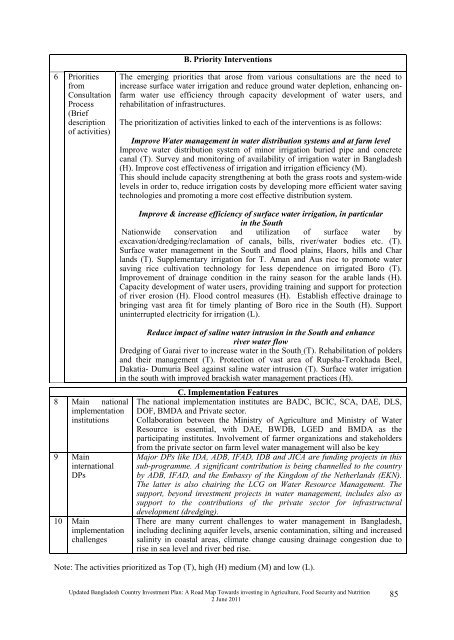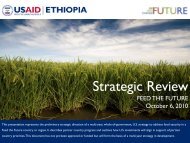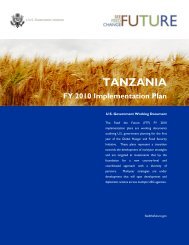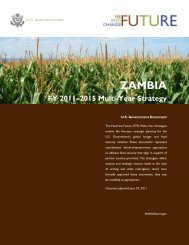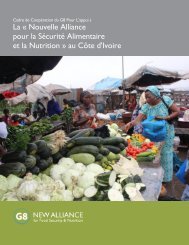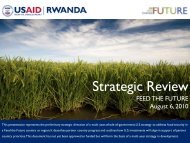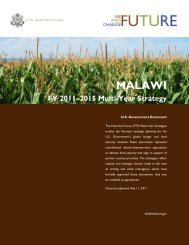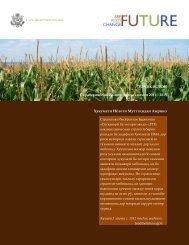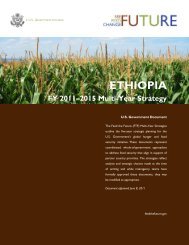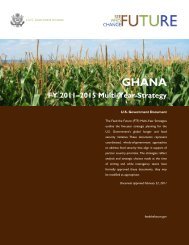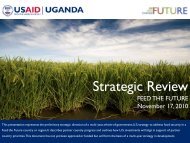Bangladesh Country Investment Plan - Feed the Future
Bangladesh Country Investment Plan - Feed the Future
Bangladesh Country Investment Plan - Feed the Future
You also want an ePaper? Increase the reach of your titles
YUMPU automatically turns print PDFs into web optimized ePapers that Google loves.
B. Priority Interventions<br />
6 Priorities<br />
from<br />
Consultation<br />
Process<br />
(Brief<br />
description<br />
of activities)<br />
The emerging priorities that arose from various consultations are <strong>the</strong> need to<br />
increase surface water irrigation and reduce ground water depletion, enhancing onfarm<br />
water use efficiency through capacity development of water users, and<br />
rehabilitation of infrastructures.<br />
The prioritization of activities linked to each of <strong>the</strong> interventions is as follows:<br />
Improve Water management in water distribution systems and at farm level<br />
Improve water distribution system of minor irrigation buried pipe and concrete<br />
canal (T). Survey and monitoring of availability of irrigation water in <strong>Bangladesh</strong><br />
(H). Improve cost effectiveness of irrigation and irrigation efficiency (M).<br />
This should include capacity streng<strong>the</strong>ning at both <strong>the</strong> grass roots and system-wide<br />
levels in order to, reduce irrigation costs by developing more efficient water saving<br />
technologies and promoting a more cost effective distribution system.<br />
8 Main national<br />
implementation<br />
institutions<br />
9 Main<br />
international<br />
DPs<br />
10 Main<br />
implementation<br />
challenges<br />
Improve & increase efficiency of surface water irrigation, in particular<br />
in <strong>the</strong> South<br />
Nationwide conservation and utilization of surface water by<br />
excavation/dredging/reclamation of canals, bills, river/water bodies etc. (T).<br />
Surface water management in <strong>the</strong> South and flood plains, Haors, hills and Char<br />
lands (T). Supplementary irrigation for T. Aman and Aus rice to promote water<br />
saving rice cultivation technology for less dependence on irrigated Boro (T).<br />
Improvement of drainage condition in <strong>the</strong> rainy season for <strong>the</strong> arable lands (H).<br />
Capacity development of water users, providing training and support for protection<br />
of river erosion (H). Flood control measures (H). Establish effective drainage to<br />
bringing vast area fit for timely planting of Boro rice in <strong>the</strong> South ( H). Support<br />
uninterrupted electricity for irrigation (L).<br />
Reduce impact of saline water intrusion in <strong>the</strong> South and enhance<br />
river water flow<br />
Dredging of Garai river to increase water in <strong>the</strong> South (T). Rehabilitation of polders<br />
and <strong>the</strong>ir management (T). Protection of vast are a of Rupsha-Terokhada Beel,<br />
Dakatia- Dumuria Beel against saline water intrusion (T). Surface water irrigation<br />
in <strong>the</strong> south with improved brackish water management practices (H).<br />
C. Implementation Features<br />
The national implementation institutes are BADC, BCIC, SCA, DAE, DLS,<br />
DOF, BMDA and Private sector.<br />
Collaboration between <strong>the</strong> Ministry of Agriculture and Ministry of Water<br />
Resource is essential, with DAE, BWDB, LGED and BMDA as <strong>the</strong><br />
participating institutes. Involvement of farmer organizations and stakeholders<br />
from <strong>the</strong> private sector on farm level water management will also be key<br />
Major DPs like IDA, ADB, IFAD, IDB and JICA are funding projects in this<br />
sub-programme. A significant contribution is being channelled to <strong>the</strong> country<br />
by ADB, IFAD, and <strong>the</strong> Embassy of <strong>the</strong> Kingdom of <strong>the</strong> Ne<strong>the</strong>rlands (EKN).<br />
The latter is also chairing <strong>the</strong> LCG on Water Resource Management. The<br />
support, beyond investment projects in water management, includes also as<br />
support to <strong>the</strong> contributions of <strong>the</strong> private sector for infrastructural<br />
development (dredging).<br />
There are many current challenges to water management in <strong>Bangladesh</strong>,<br />
including declining aquifer levels, arsenic contamination, silting and increased<br />
salinity in coastal areas, climate change causing drainage congestion due to<br />
rise in sea level and river bed rise.<br />
Note: The activities prioritized as Top (T), high (H) medium (M) and low (L).<br />
Updated <strong>Bangladesh</strong> <strong>Country</strong> <strong>Investment</strong> <strong>Plan</strong>: A Road Map Towards investing in Agriculture, Food Security and Nutrition<br />
2 June 2011<br />
85


